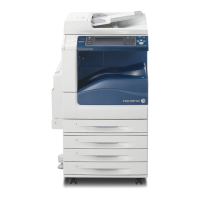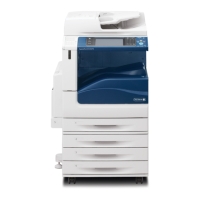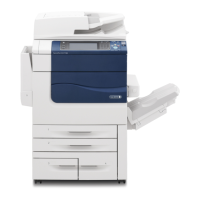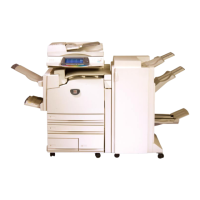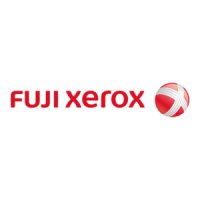
Do you have a question about the Fuji Xerox ApeosPort-IV C2275 and is the answer not in the manual?
| Functions | Print, Copy, Scan, Fax |
|---|---|
| Print Technology | Laser |
| Print Speed (Color) | 25 ppm |
| Print Speed (Mono) | 25 ppm |
| Print Resolution | 1200 x 1200 dpi |
| Memory | 2 GB |
| Scan Resolution | 600 x 600 dpi |
| Fax Modem Speed | 33.6 kbps |
| Supported OS | Windows, macOS, Linux |
| Type | Color Multifunction Printer |
| Paper Size | A4, A5 |
| Connectivity | USB 2.0, Ethernet |
| Scanner Type | Flatbed, ADF |
| Duplex Printing | Automatic |
| Copy Speed (Color) | 25 cpm |
| Copy Speed (Black & White) | 25 cpm |
Provides an introduction to the user guide, its purpose, and required user knowledge.
Details the various accompanying manuals and guides provided with the machine.
Explains the structure of the guide, its intended audience, and conventions used.
Provides essential safety instructions and warning symbols for using the machine safely.
Details regulatory information, including radio frequency emissions and RFID certification.
Provides information on environmental protection, resource use, and proper disposal of consumables.
Details software licenses, cryptographic software, and third-party codes used in the product.
Warns about illegal copying or printing of documents and potential penalties.
Details the machine's components and their respective functions.
Explains how to switch the main power and the machine power on and off.
Explains the circuit breaker's function and how to check its proper operation.
Describes the Low Power and Sleep modes of the Energy Saver feature.
Details the names and functions of components on the machine's control panel.
Describes the [Services Home] screen, its fields, and how to access various services.
Explains how to enter text using the on-screen keyboard, including special characters.
Provides instructions for attaching a tray to the Finisher-B1 for neat paper stacking.
Details basic procedures for loading documents and starting a copy job.
Describes operations during copying, such as stopping or interrupting jobs.
Allows selection of basic features for copying on a single screen.
Describes features on the [Copy] screen, including reduce/enlarge and paper supply.
Covers adjusting original type, density, sharpness, saturation, and image enhancement.
Details layout adjustments like 2-sided copying, book copying, and edge erase.
Describes output format options like booklet creation, covers, and pages per side.
Explains features for processing scanned documents with different settings as one job.
Details basic procedures for loading documents and starting a fax job.
Describes operations during faxing, such as stopping jobs or changing scan settings.
Explains Internet Fax, its features, and how it differs from general fax transmission.
Describes IP Fax (SIP) for sending and receiving faxes over an IP network.
Explains the Server Fax service, its features, and how it transfers image data.
Allows selection of basic features for sending faxes on a single screen.
Describes Fax/Internet Fax features like destinations, resolution, and 2-sided scanning.
Details layout adjustments for faxing, such as 2-sided scanning and original size.
Covers options like acknowledgement reports, priority send, delay start, and cover pages.
Describes features like remote polling, store for polling, and on-hook dialing.
Explains Broadcast Send and Relay Broadcast for transmitting documents to multiple recipients.
Describes fax receiving modes like auto, manual, and folder receive.
Information on using the receiver for facsimile information services.
Details basic scanning procedures, including loading documents and starting scan jobs.
Describes operations during scanning, such as stopping jobs or changing scan settings.
Explains scanning documents and sending them as e-mail attachments.
Describes scanning documents using job templates from CentreWare Internet Services.
Details scanning documents and sending them to a network computer via FTP or SMB.
Explains scanning documents and saving them in machine folders.
Describes scanning documents and saving them to a USB memory device.
Authenticates, scans, stores data, and sends email with retrieval and deletion URLs.
Allows scanning documents from a network computer and saving data to it.
Covers color scanning, original type, image options, and image enhancement settings.
Details layout adjustments for scanning, such as 2-sided scanning and original size.
Covers file format, quality, read receipts, split send, and file naming options.
Describes how to operate files stored in folders for print, scan, and fax.
Explains how to select a folder from the [Send from Folder] screen.
Describes how to check or operate files in a folder, including display styles and file types.
Allows previewing selected files to check details, including whole page view and rotation.
Provides instructions to print selected files from a folder.
Describes how to register transfer settings for scan data to simplify data transfer.
Details procedures for operating a job flow, including opening and starting the sheet.
Describes how to manage existing job flows.
Explains storing and recalling frequently used settings with a single button operation.
Provides procedures for registering, deleting, and renaming stored programs and icons.
Describes how to call a stored program, including for Build Job, and selecting other features.
Introduction to the Web Applications service.
Details accessing web applications by registering destinations and selecting them.
Shortcut for accessing applications via [Services Home] screen buttons.
Introduction to the Media Print service.
Instructions for inserting USB memory devices.
Describes selecting files and printing options for text documents.
Details selecting files and printing options for photo images.
Customizing print settings like quantity, output color, and paper supply.
Explains checking current, pending, and completed jobs, and cancelling jobs.
Managing active jobs.
Reviewing past jobs.
Managing jobs stored via Secure Print, Sample Set, etc.
Forcibly printing jobs waiting in queue.
Resolving job errors.
General capabilities from a computer.
Sending print jobs to the machine.
Printing documents received via email.
Sending faxes directly from a computer.
Getting scanned files from the machine to the computer.
Web-based machine management.
Definitions of technical terms.
